SHINKANSEN (BULLET TRAINS)
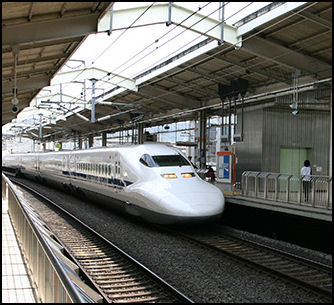
The super fast trains in Japan are called the Shinkansen. Shinkansen literally means “new trunk line.” The term “bullet train,” which is widely used in the West, is derived from the rounded front of the original Shinkansen. Shinakensen trains go as fast as 170 miles per hour.
The Shinkansen is famous for reliability, safety and punctuality. The average delay is usually around 10 seconds. Since it was inaugurated in 1964, the Shinkansen has had a remarkable record of high-speed operation, safety, volume of transport, and punctuality. As many as 14 trains every hour run in each direction on a single line, while train delays average between just 0.6 and 1.0 minutes. In 2004 when the average delay increased to 42 seconds as a result of typhoons, earthquakes and some other problems it was considered a disgrace. Moreover, not a single fatal accident has occurred from a collision or derailing on a Shinkansen line since operations began, setting an amazing record for safety.
Shinkansen lines extend for 2,397 kilometers. The bullet trains travel on a 25,000 volt electric line on tracks welded smoothly together to eliminate the clackety noise caused by conventional railway joints. The trains have a computerized system that automatically slows the train if an earthquake is sensed. In over 40 years of service there has never been a fatality.
The Shinkansen and Japanese trains in general are credited with keeping cars off the highway. As of 2004, the Shinkansen had carried more than 7.1 billion passengers.
Hiroko Tabuchi wrote in the New York Times, “Japan has confidence in its bullet train technology. In the decades since its first bullet train pulled out of Tokyo Station on Oct. 1, 1964 — just 10 days before the nation held its first Olympics — the high-speed rail network has had no fatal accidents. Japanese officials are also quick to point out the trains’ down-to-the-minute punctuality, despite a heavy passenger flow of 300 million people a year.”
Good Websites and Sources: Good Photos at Japan-Photo Archive japan-photo.de ; JR Shinkansen siteJR Shinkansen ; Railway Technology railway-technology.com/projects/shinkansen ; Wikipedia article Wikipedia ; “Biting the Bullet — Academic Paper japanesestudies.org.uk ; N — 700 Shinkansen railway-technology.com ; Good pdf file Map railkey.com ; Book: “Shinkansen: From Bullet Train to Symbol of Modern Japan” By Christopher Hood
Links in this Website: BICYCLES AND MOTORCYCLES IN JAPAN Factsanddetails.com/Japan ; URBAN TRANSPORTATION IN JAPAN Factsanddetails.com/Japan ; TRAINS IN JAPAN Factsanddetails.com/Japan ; SHINKANSEN (JAPANESE BULLET TRAINS) Factsanddetails.com/Japan ; AUTOMOBILES AND DRIVING IN JAPAN Factsanddetails.com/Japan ; AUTOMOBILES ACCIDENTS IN JAPAN Factsanddetails.com/Japan ; HYBRIDS, FUEL CELLS AND ELECTRIC CARS IN JAPAN Factsanddetails.com/Japan ; AIR TRAVEL AND AIRLINES IN JAPAN Factsanddetails.com/Japan ; SHIPPING AND BOAT TRAVEL IN JAPAN Factsanddetails.com/Japan ; INFRASTRUCTURE AND PUBLIC WORKS IN JAPAN Factsanddetails.com/Japan
Good Websites and Sources on Transportation: Good Photos at Japan-Photo Archive japan-photo.de and japan-photo.de ; Ministry of Land, Infrastructure, Transport and Tourism mlit.go.jp ; Statistical Handbook of Japan Transport Chapter stat.go.jp/english/data/handbook ; 2010 Edition stat.go.jp/english/data/nenkan ; News stat.go.jp
World’s Fastest Trains
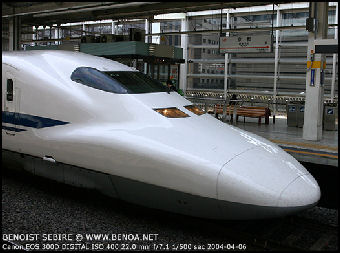
In 2007 a TGV train in France broke the world speed record when it reached a speed of 357 mph (575 kph). The train was modified and carried no passengers and reached the high speeds on special straight track. The fastest TGV service reaches speeds of 320 kph, about 20 kilometers per hour faster than the Shinkansen.
In December 2010, a Chinese passenger trains achieved a record speed of 486 kph on a test run of the track between Beijing and Shanghai. The Chinese said that it was the fastest speed recorded by an unmodified conventional commercial train.A Japanese maglev train reached 581 kph in 2003.
The fastest shinkansen trains in service reach speeds of 300 kph. They operate on the Osaka-Fukuoka section of the main shinkansen line. A 320 kph shinkansen — that would equal the speed of the world’s fastest trains in France — are scheduled to operate between Tokyo and Aomori in Japan, with the train reaching a speed of 360 kph on the 100-kilometers extension through Tohuku to Aomori in far northern Japan.
One well-traveled businessman told the Washington Post he likes the bullet train better because the TGV "goes so fast you get sick looking out the window." Describing a ride on the 270kph Asama Bullet Train from Tokyo to Nagano one woman told the Washington Post, "In most trains you feel you have a connection the ground. You feel the jolts, you feel the bumps. The biggest difference is that you feel movement, but you don't feel the ground."
The world's fastest train services in 1997 (based on start-to-stop average speed): 1) the Japanese Nozuma Shinkansen from Hiroshima to Kokura (162 mph); 2) the French TGV between Lille and Roiseey (158 mph); 3) the French TGV between Mons, Belgium and Paris Nord (131 mph); 4) the Spanish EVE between Madrid and Seville (130 mph); 5) the German ICE between Wuerzburg and Fulda (124 mph); 6) the British IC225 between London King Cross and York (112 mph); 7) Swedish X2000 between Hassleholm to Alvesta (104 mph). [Source: Railway Gazette International, Washington Post, 1997]
History of Bullet Trains
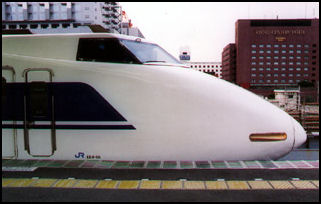
Series 100 train The Shinkansen was launched in 1964 to coincide with the Tokyo Olympics. On October 1, 1964, the same day an inauguration rally was held for the Olympic athletes, two bullet trains left simultaneously from Tokyo and Shin-Osaka stations. They traveled at 222 km/hr and helped elevate Japan to the ranks of the world's most technological advanced nations. The last of the original bullet trains — the O Series Shinkansen — were taken out of service in November 2008.
The bullet train was invented by Hideo Shima, who convinced the Japanese government and then the World Bank to finance the project. The first bullet train — the 320-mile-line between Osaka and Tokyo — was built on a wide-gauge track with 400-meter rails to reduce bumps and shaking. The trains had airplane-like sealed windows and air conditioning and an advanced suspension. Instead of a line of cars pulled by a locomotive, each carriage has its own electric motor.
The key to achieving high speeds was making the run as straight and level as possible and having as few stops as possible. The biggest expense in building the Osaka-Tokyo line was constructed 3000 bridges and 67 tunnels. Much of the line is built on an elevate track. Towns not near the Shinkansen lines have seen their populations decease as people have moved to places close to the Shinkansen lines.
In 1999, many old bullet trains were phased out to make room for the new 700 series Nozomi trains which travel 285kmp compared to 210kph for the old bullet trains. The O Series Shinkansen — the original bullet trains — have traveled a combined total distance equal to traveling 30,000 times around the circumference of the earth. Unlike newer models, they were made of steel rather than aluminum and were prone to erosion, with rainwater forming rust, and needed a lot of maintenance work. The final run of the O Series Shinkansen was in December 2008. Train fans packed stations to take photos and have one last look at the train while it was still running. A farewell ceremony was held at JR Hakata Station in Fukuoka, Kyushu.
Shinkansen Lines
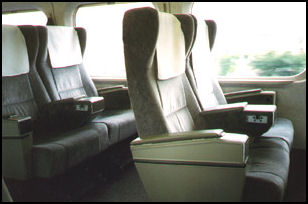
Shinkansen seats
The Shinkansen system consists of six regular lines: the Tokaido Shinkansen, Sanyo Shinkansen, Tohoku Shinkansen, Joetsu Shinkansen, Hokuriku Shinkansen (currently travels as far as Nagano), and Kyushu Shinaksen, for which trains run only on special Shinkansen tracks; as well as two lines usually referred to as “mini-Shinkansen” lines, where the trains run both on Shinkansen tracks and standard local tracks: the Akita Shinkansen and Yamagata Shinkansen. [Source: Web-Japan, Ministry of Foreign Affairs, Japan]
“This extensive network of high-speed trains exceeding 300 kilometers per hour (186 MPH) connects Japan’s major cities, stretching from Aomori on the northernmost point of the island of Honshu all the way down to Kagoshima on the southernmost point of Kyushu. The addition of several other Shinkansen lines has been planned since 1973, and construction continues on some sections of those lines. The Tokaido Shinkansen serves the 500- kilometer (311-mile) Tokyo-Osaka corridor that has long been considered the main artery of Japan. This line runs at a maximum speed of 270 kilometers per hour, and the minimum trip time between Tokyo and Osaka is now 2 hours 25 minutes.
The main shinakensen line runs between Tokyo, Nagoya, Kyoto, Osaka, Hiroshima and Hakata in Kyushu. The line that runs between Tokyo and Sendai and Morioka in northern Japan was extended 97 kilometers northward to Hachinohe in Aomori Prefecture in December 2002. Another line heads north from Tokyo and branches off at Fukushiama to Yamagata. Another line goes from Tokyo to Niigata on the north coast of central Honshu. The line built for the 1998 Olympics travels between Tokyo and Nagano in the Japanese Alps.
The Sanyo Shinkansen opened in 1972; the Tohuku Shinkansen and Joetsu Shinkansen opened in 1982; the Hokuriku Shinkansen opened in 1997, and the Kyushu Shinkansen opened in 2003. The sinkansen between Tokyo and Nagano, built for the 1998 Winter Olympics, reduced the travel time for the 120-mile distance between the two cities from three hours to 79 minutes but cost $7 billion (or $69 million a minute).
New Shinkansen Lines
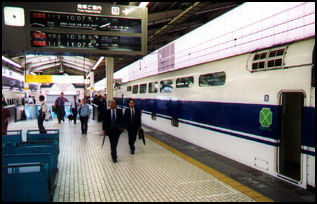
Tokyo platform Construction of new Shinkansen line is currently underway in Hokkaido and nd Kyushu.
The main shinakensen line in northern Japan runs between Tokyo, Sendai, Morioka, Aomori and Hakodate in Hokkaido. It was extended 97 kilometers northward from Morioka in Iwate Prefecture to Hachinohe in Aomori Prefecture in 2002 and finally reached Aomori City in 2010. From Shin-Aomori, the line continues to Shin-Hakodate through the world's longest undersea railway tunnel, the Seikan Tunnel. This section is 150 kilometers (93 miles) long and opened in 2016 under the name Hokkaido Shinkansen. The 211 kilometer (131 mile) section to Sapporo is due to open by 2030. It takes about 2 hours and 10 minutes from Tokyo to Morioka Station on the Tohoku Shinkansen line. To reach Akita there is a mini shinkansen line. Another Shinkansen line heads north from Tokyo and branches off at Fukushima to Yamagata.
Southern Hokkaido became connected to the shinkansen system in 2016 when the new line was completed between Aomori in northern Honshu and Hakodate in Hokkaido and between Hashinohe and Aomori in Tohuku northern Honshu. Work began in May 2005 on s ¥472.6 billion, 10-year-year project to extended the Shinkansen to Hakodate, a city with only 260,000 people in Hokkaido. Construction to Sapporo has not yet started.
The Shinkansen from Fukuoka to Kagoshima, connecting northern and southern Kyushu, is now open. In March 2003, the first stretch of the Kyushu Shinkansen opened. It traverses the 127 kilometers between Kagoshima in southern Kyushu and Yatsushiro in central Kyushu in 37 minutes, compared to 122 minutes for an ordinary train. The section between Yatsushiro and Hakata in northern Kyushu was finished in 2012.
The Horuriko shinkansen line from Nagano to Toyama to Kanazawa in western Honshu is under construction and is scheduled to begin operations in 2014. With the new lines the travel time between Tokyo and Toyama will be reduced from 3 hours and 11 minute to two hours and seven minutes. Construction from Kanazawa to Osaka has not yet started.
Other new lines that schedule to be built include one that will connect Takeo Onsen with Isahaya in Nagasaki Prefecture in Kyushu. Many thinks the costs of these line far outweigh their benefits and the project should scrapped and money spent on other things. Construction has not yet started.
Around ¥2 trillion is needed to finish these news shinkansen lines. Finding these money is problematic. Under current laws two thirds of the financing comes from the central government and one comes from the local governments of regions through which the lines pass. Many local government find that coming with money the shinkansen line and tremendous burden and have refused to pay their share.
In June 2012, Jiji Press reported: “The government approved construction of three new sections of track as part of a plan to extend Shinkansen services. Transport minister Yuichiro Hata approved the construction after he and his deputies concluded that all prerequisites for the projects have been fulfilled. This is the first approval of new Shinkansen tracks in four years, and the first such approval since the Democratic Party of Japan took power in 2009. Construction costs are expected to be about 3.04 trillion yen ($38.8 billion). [Source: Jiji Press, June 30, 2012]
“The Shinkansen is key for a sustainable and vibrant nation," Hata said. The extensions will link Sapporo with Shinhakodate on the northern Hokkaido Line, Kanazawa with Tsuruga on the northwestern Hokuriku Line, and Isahaya with Nagasaki on the southern Kyushu Line. 1 trillion yen of the cost will be covered by fees charged to Japan Railway group companies for the use of tracks and other facilities on existing Shinkansen lines. The rest will be financed by the central and municipal governments.
“The new routes will open in fiscal 2022 on the Kyushu Line, fiscal 2025 on the Hokuriku Line and fiscal 2035 on the Hokkaido Line. Construction of lines usually takes about 10 years. However, the government drew up the plans with the aim of reducing annual costs. Once the new routes are open, it will take five hours and one minute between Tokyo and Sapporo, three hours and eight minutes between Tokyo and Tsuruga, and one hour and 20 minutes between Hakata and Nagasaki.
Shinkansen Trains
The are several different Shinksen trains. The original Shinaksens belong to the 0 series. They were replaced in the 1970s by the more comfortable Series 100 trains, which continued running until 2003. In 1992, the Series 300 Nozumi trains made their debut. They were built largely of aluminum, were 25 percent lighter and had a maximum speed of 270kph. The newest train is the Nozumi Type-500. It has a maximum speed of 300kph and covers the 905-kilometer route between Tokyo and Hakata on Kyushu in 4 hours and 49 minutes.
The Nozumi shinkansen introduced in 1992 cut the travel time between Tokyo and Osaka by 30 minutes to 2 ½ hours. The N700 trains introduced in 2007 cut the time by only 5 minutes. It speeds are virtually impossible to increase.
New Shinkansen Trains
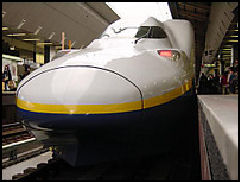
The Fastech 360-Z is a new generation of Shinkansen. It looks sort of like a giant, snub-nosed, blue shark. It has orange retractable brakes that look like ears that pop out to slow the train by creating drag and wind resistance. The train has reached speeds of 398 kilometers per hour in tests and will travel at speeds of 360 kph when it goes into service in 2011 on the Tohuku line between Tokyo and Aomori
The latest N-700 Shinkansen models are capable of traveling at 522 kilometers per hour. The are made with cutting edge materials and parts that make them lighter and faster. They also have a train tilting system that allowed the coaches to lean into corners so the train can negotiate curves at high speeds.
The latest Shinkanesen, the E5, which will debut in the Tohoku line to Aomori when its opens in December 2010, can reach speeds of 320 kph, making it the fastest in Japan. It has a funny-looking, 15-meter-long nose, designed to minimize noise when go through tunnels.
Shinkansen manufacturers have adopted aircraft production technology for trains. New experimental models have longer noses for less air resistence and a mechanism that allows the cars to tilt in curves to reduce deceleration. Many of the new trains are built by Hitachi at a factory ay Kasado near Hiroshima. The elongated noses are able to absorb 50 percent of impact of a head on crash and their light aluminum shells reduce vibrations.
New Shinkansen Introduced in 2011
The new greenish-blue, bubble-nosed E-5 Hayabusa Shinkansen train made its debut on the Tohoku Shinkansen line in March 2011. The first entirely new Shinkansen model to be introduced in 14 years, it has a top speed of 300 kph. The speed that will be increased to 325 kph at the end of 2012, making it the fastest train in the nation, and enabling passengers to travel the 713.7-kilometer distance between Tokyo and Aomori in three hours and five minutes. The regular Shinkansen covers the distance in three hours 20 minutes. "It's not just a matter of speed," Tomoyuki Endo, section chief of JR East's vehicle technology center, told the Yomiuri Shimbun. "The Hayabusa runs more smoothly and quietly than the Hayate even at 320 kph." [Source: Motoshi Sakata, Yomiuri Shimbun, February 28, 2011]
Motoshi Sakata wrote in the Yomiuri Shimbun, “Increased speed brings increased air resistance, which inevitably causes greater buffeting. Therefore, the company installed sensors on the Hayabusa to detect buffeting toward either the right or left that is strong enough to be felt by passengers. Signals are immediately sent to a device designed to counteract the buffeting, which is installed between the platform frame that rides on the train's wheels and the body of train carriages.”
“When the Hayabusa negotiates curves at high speed, compressed air is pumped into air springs installed on the bottom of carriages to counteract the centrifugal force generated in the curves. By controlling both aerodynamic buffeting and centrifugal force for the first time in the world, JR East said it realized "a ride [on the Hayabusa] so smooth that even a pencil left standing upright would not fall over."
“As trains generate high noise levels when they pass through tunnels, the 15-meter nose on the front car of the Hayabusa is aerodynamically designed to minimize tunnel noise. To further reduce noise, the rail company developed a special pantograph and put covers over wheels and carriage couplings.”
“The new train also features an 18-seat Gran Class car, which is equivalent to first class on an aircraft. The Gran Class leather seats are 52 centimeters wide and recline 45 degrees. To allow passengers to extend their legs, there is 1.3 meters of space between seats....Gran Class fares are 5,000 yen more than those for a green-car seat. However, when the advance tickets went on sale on Feb. 5, all the Gran Class seats of six Hayabusa runs on the first day sold out in 20 seconds.”
“The sophisticated technologies used for the Hayabusa ballooned the production cost of the 10-carriage train to about 3.6 billion yen, about 1.5 times the Hayate's price of about 2.5 billion yen.” "The issue to solve in the future is how we can cut the cost while maintaining current efficiency," JR East's Endo said.
“The new Shinkansen train is attracting the attention of railway buffs. For three days of demonstration rides offered on February 18-20, the company received 246,252 applications for 4,000 seats over a 10-day period.
Bullet Train Problems
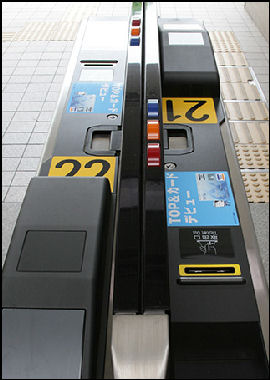
During the Niigata quake in October 2004 a Shinkansen bullet train derailed. It was the first time since the high-speed train was introduced that one derailed. About 150 people were on the train at the time. None were injured even though it was traveled at 125mph when the quake struck and was rocked from side to side by the quake. While the train was being put back on the track with a crane another earthquake hit. Full services was resumed 66 days later.
Occasionally someone commits suicide by leaping in front of a shinkansen. When that happens service is generally stopped for two to two and half hours. Since the engine is sometime damaged by the victim’s body it has to be replaced. While that is done passengers are released and told to wait.
In July 2007, a Shinkansen train hit and killed a man near a station in Saitama near Tokyo. Trains service on that Shinkansen line was suspended for 110 minutes. The main had climbed over a fence and walked onto the railway line.
In 2008 the door handles of some trains were modified after passengers opened the doors on trains either to commit suicide by jumping to their deaths or as a prank. The suicides seriously disrupt shinkansen traffic because of the time required for police to investigate the scene. In April 2008, train service was stopped for up to three hours on main line between Tokyo and Osaka, with some passengers forced to spend the night on the train, after man leaped to his death from a moving train in Shizuoka Prefecture.
In March 2003, a shinkansen train stopped at about 100 meters before its regular stopping point after the driver of the train fell asleep for eight minutes while the train was traveling at speeds up of up to 270 kilometers per hour. A disaster was averted because the train was equipped with an automatic control system that stopped the train when it pulled into the station. It was later revealed that the driver had a sleep disorder. Shinkansen driver go through rigorous training.
Once a one-meter long snake became entangled in an insulator and caused a power failure that disrupted Shinkansen service for one hour.
In January 2010 shinkansen service between Tokyo and Osaka was delayed 3½ hours after a cable that supplies electricity to the trains was severed. An investigation revealed that it was severed by the train’s pantograph — the part of the train that touches the cable — which fell off because maintenance workers failed to attach the bolts that hold it in place.
In January 2011, a system failure caused all five Shinkansen lines of the East Japan Railway company to be suspended for 75 minutes. Fifteen trains were canceled and 58 were delayed, affecting 53,000 people.
Shinkansen Trains Overseas
Increasing Japanese train manufacturers are looking abroad for new markets. Hitachi operates a plant in Britain that supplies train cars for Europe. Kawasaki Industries is one of the leading suppliers for the New York City transit system.
The Japanese government and representatives of Japanese companies that run trains and make them are lobbying hard in the United States and other countries to get them to adopt shinkansen technology in their drive to put faster trains in service in more places. Shinkansen system are in operation in Taiwan (See Taiwan) and have been ordered by Britain. France, Germany and Japan are trying to sell high-speed railway technology to China for the planned Beijing-Nanjing-Shanghai high-speed rail route (See China).
Japanese companies are involved in a number of train projects around the world. Hitachi supplies trains to the British section of the Eurostar. Kawasaki Heavy Industries is developing a high speed service for services in the United States. Mitsubishi began production of brakes and electric engines for trains at a factory in Mexico.
Hitachi won priority negotiating rights in 2009 to replace the 1,400 cars on Britain’s high-speed rail lines with new ones, a deal worth an estimated $11 billion, but that deal was put on hold when a new conservative government lead by David Cameron came to power in May 2010. In March 2011, it seemed the bid was back on track as the British resumed negotiations on the new train carriages, this time a $6 billion deal for about 100 trains.
Japan has also been keen to market its high-speed rail technologies to emerging economies. Earlier this month, Mr. Maehara visited Vietnam to negotiate financing for a 1,570-kilometer (975-mile) high-speed rail link that will link the country’s south to the capital, Hanoi, in the north.
Japan had aggressively sought the contract to build a high-speed 510-kilometers railway between Rio de Janeiro and Sao Paulo, with trains that will reach 300 kilometers per hour. A consortium led by Mitsui & Co. has made a pitch to get the contract. Later the Japanese train maker decided to pull out of the Brazil high-speed deal, saying the chances of 40-year project being profitable were slim.
Japan Seeks High-Speed Train Deals in the United States
In the United States, Japanese companies are responding to a call by President Barrak Obama to build a better high-speed rail service there. They are seeking a deal in the United States, where 11 high speed train lines with a combined length of 13,700 kilometers have been proposed, including one line between Los Angeles and San Francisco.
In February 2011, the United States announced it would invest $53 billion in high-speed rail networks over six years. Japan has high hopes of selling some of its Shinkansen technology in the effort. Top Japanese government officials, including the transport minister, Seiji Maehara, have traveled to the United States to lobby Japanese trains. But these plans were given a set back when the U.S. Transportation Department said it would withdraw $2.4 billion in funds from a Florida high-speed railway project after the Republican governor in Florida said he would reject the money for the project.
In September 2010, California governor Arnold Schwarzenegger came to Japan to check out the Shinkansen with an eye on using the train or its technology for a proposed $40 billion high-speed rail project in his state that will include ne line between Los Angeles and San Francisco. He said, I am very impressed with the technology and also with the infrastructure itself. He also visited China , South Korea and Europe to check out the high-speed trains in those places.
An important consideration for the Obama administration is that it wants to make sure that any foreign companies that supply high-speed rail works also bring jobs to the United States. United States transportation secretary, Ray LaHood, said, “The only thing that we ask of manufacturers is, come to America, find facilities to build this equipment in America and hire American workers,” Other railroad powerhouses — including Bombardier of Canada, Siemens of Germany and Alstom of France, as well as General Electric and Lockheed Martin of the United States — all want pieces of the action.
Japanese Train Technology Abroad
In 2012, the Yomiuri Shimbun reported: “Japan's rail technology has caught the eye of such nations as Brazil, India and Vietnam for its safety even during major earthquakes, as well as the elaborately designed, highly reliable train operation systems. Many emerging economies have decided to build new railway networks both fueled by and to facilitate red-hot economic growth. The high quality of Japan-made train cars and other equipment, however, comes with a big price tag. [Source: Yomiuri Shimbun, July 12 2012]
“To ta into international interest in Japanese train technology Japan International Consultants for Transportation Co., a new firm jointly capitalized by 10 railway operators including East Japan Railway Co., was created and began operations in April 2012. Hiroshi Komatsu, director of Japan Consultants' planning and marketing headquarters, told the Yomiuri Shimbun, "Japan is one of the very few countries that has been successful in operating profitable railways.We want to show emerging economies how adopting safe and reliable Japan-developed rail systems can benefit them in the long run," he said.
“Taiwan High Speed Rail (THSR), sometimes called the Taiwan Shinkansen, opened in 2007 and was the first place Japan's Shinkansen technology was employed overseas. The THSR contract was initially awarded to a consortium of German and French companies, but in wake of a massive earthquake that struck Taiwan in 1999, a consortium of Japanese firms including Mitsui & Co. snatched the contract away, primarily because Taiwan took a second look at Japan's earthquake-resistant technology.
“About 120 THSR employees underwent training by Central Japan Railway Co. and other Japanese rail operators. "The Taiwanese trainees were drilled thoroughly on fundamentals such as on-time train operation and regular equipment inspections," according to one person familiar with the training. THSR placed orders with Kawasaki Heavy Industries and other domestic train car manufacturers for 48 bullet train cars earlier this year, a contract worth about 19 billion yen.
Maglev Magnetic Trains in Japan
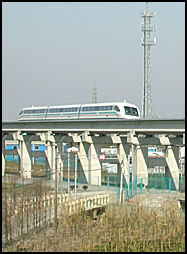
Shanghai maglev Japan and Germany have experimented with MAGLEV trains (magnetically levitated trains that float above the track on a cushion generated by superconducting magnet). A Maglev train has been built in Shanghai. Based on linear motor technology, the Japnese Maglev train levitates above its track using magnetic energy and is capable of reaching maximum speeds over 550 kilometers per hour (342 mph). If completed sometime early in the twenty-first century, such trains can be expected to make the journey between Tokyo and Osaka in approximately 1 hour, about the same time required by jet aircraft.
JR Central runs the MLX01 maglev bullet train, still in its testing phase. The Japanese program began in 1962, with testing starting in 1997 on the 18.4-kilometer test line between Tsuru and Otsuki, 30 miles north of Miyazaki, in Yamanashi Prefecture on Kyushu. In 1999, the Japanese maglev train has reached speeds of 552 kph (325mph). In 2003 it clocked the world’s fastest trial run of 581 kilometers (361 miles) an hour. French high speed trains have reached 515kph.
In April 2003, 480 people were taken on 500kph ride on a maglev test line Yamanishi Prefecture. Describing the ride Hiroyuki Nakamura wrote in the Yomiuri Shimbun, “The train began its run on wheels just like an ordinary electric train. But when it reached a speed of about 169 kph, it shifted into maglev mode...I felt the train rise into the air for a moment. the noise of the wheels stopped, and I heard a sound similar ro that of an airplane housing its wheels after take off...The speedometer installed in the passenger cabin clocked off every 10kph as the speed increased. In about a minute it topped 500kph.
Maglev Train Routes in Japan
The Central Japan Railway Company has announced that it plans to build the fastest train in the world, between Tokyo and Nagoya, to be completed by 2027. The new line, estimated to cost about $64 billion, runs about 290 kilometers (178 miles) on part of an existing Tokyo-to-Osaka line; the company expects speeds up to 310 miles per hour, shaving travel time between the two cities to 40 minutes from about 95 minutes. The Shinkansen covers the distance in 55 minutes. The JR Tokai said it will build and foot the bill for the maglev project.
An extension of the high-speed line to Osaka is planned by the end of 2045. Many technical obstacles have to be overcome. The cost of building a maglev line between Osaka and Tokyo is estimated at $80 billion. The train would travel between Japan's two largest cities in an hour, compared to 2½ hours for the fastest Shinkansen. Critics say the railway will never be built because its too expensive.
Construction is underway to extend the current track from 18.4 kilometers to 42.8 kilometers, connecting Kofu and Sagamihara in 15 minutes, and have it ready by the 2020, at which time people will be able to pay for the thrill of riding 500 kph on the train. Then the idea is to use money generated from thrill rides and each new section to pay for construction of subsequent sections. Service between Tokyo and Nagoya will take about 40 minutes and start in 2027.
JR Tokai aims to begin construction on a maglev train between Tokyo and Nagoya in 2014 or 2015. There is a dispute over the proposed route of the maglev between Tokyo and Nagoya. The most direct and cheapest route — costing a mere $51 billion — is through the Southern Japanese Alps. The other routes that skirt north of the Southern Alps are 1) the $57 billion Inadani route and 2) the $56 billion Kisodani route. There is intense lobbying by towns along the various route who stand to gain significantly of the train goes through their town.
The Maglev project between Tokyo and Osaka was given the green light in December 2011. The shortest route is most likely to get the nod.
How Maglev Trains Work
Maglev, short for “magnetic levitation,” uses powerful magnets that allow the train to float just above the track, reducing friction. The train starts off on wheels, then gravitates upward after reaching high speeds. Japanese maglev linear engines are powered by the interaction between superconducting magnets (made with a niobium-titanium alloy and cooled to near absolute zero with expensive liquid helium refrigeration systems) on the trains and track. Each train magnet is simultaneously pushed and pulled by a magnet of the same polarity on the side of the track. The polarity of the side magnets is constantly reversing and the speed in which they reverse determines the speed of the train.
The train floats as result of repulsion of magnets of the same polarity on the train and the bottom of the track, which lifts the train above the track. There is virtually no friction, which allows the train to travel so fast. The ride in a maglev train feels like the ride in an airplane. Yoshiyuki Kasai, chairman of Central Japan Railway Co., wrote in Yomiuri Shimbun “superconductivity is a phenomenon where electrical resistance of certain metals falls to zero at ultralow temperatures (for niobium-titanium the SCMAGLEV train adopts, the temperature is minus 269 C). Meeting zero resistance, it is possible to apply a large electric current and create an extremely strong magnetic field. This superconducting magnet is the key technology that enables levitated travel at very high speeds. Car interiors are kept at a magnetic field equivalent to that found in ordinary living environments by shielding the superconducting magnets and coils.” [Source: Yoshiyuki Kasai, Yomiuri Shimbun, August 1, 2011]
Problems with maglev trains include: 1) the incredible weight of the magnets and refrigeration systems, causing trains cars to weigh up as much as 100 tons; 2) magnetic repulsion is inherently unstable because of the way the magnets repel one another so the guideway has to be perfectly smooth so the maglev train can float at a constant six inches above the track; 3) heavy shields are needed to protect passengers from the powerful magnets which can stop watches and pacemakers; and 4) trains tend to move back and forth and up and down, an effect which can be dampened with shock absorbers.
Costs and Advantages of Maglev
Building a maglev line is very expensive. The main expense is the elevated concrete guideway with embedded aluminum loops and magnets. The cost of liquid helium used as a coolant to create superconductivity us also very high. If superconductors are improved to achieve temperatures high enough for liquid nitrogen then the costs will be cut by a factor of 100. For the train to reach ultra-high speeds the track must be straight, and curves must be banked like those on a bobsled course. Limiting factors that prevent the train from reaching higher speeds are air resistance and tunnels.
But cost is a problem, with even a limited maglev system costing millions of dollars. The high costs have meant that JR Central, struggling with a decline in passenger traffic, is not set to open its own maglev line anytime soon. Japan and Germany, which also developed maglev technology, have yet to find commercial applications for maglev technology. In February 2000, Germany announced that it was dropping its plan to build a maglev train because of worries about cost and doubts about whether passengers will pay higher fares for the train.
Yoshiyuki Kasai, chairman of Central Japan Railway Co., wrote in Yomiuri Shimbun, “The SCMAGLEV represents a major environmental contribution by Japan that has the potential to greatly enrich people's lifestyles. For while its high-speed performance and convenience will encourage people to shift away from aircraft and automobiles, the SCMAGLEV will consume only half the amount of energy, emitting one-third the amount of carbon dioxide compared to aircraft or passenger cars. [Source: Yoshiyuki Kasai, Yomiuri Shimbun, August 1, 2011]
The result of preliminary research in the United States shows that the huge reduction in travel time afforded by the ultrahigh-speed SCMAGLEV is sufficient to bring about a significant enough shift away from automobile travel to enable a highly profitable SCMAGLEV operation and attract private investment...he best way to utilize the SCMAGLEV would be to offer it as an alternative to shuttle flights and automobiles that have reached saturation levels along the northeast corridor, improving the flow of the whole transport network of United States.
Selling Maglev Technology Abroad
Hiroko Tabuchi wrote in the New York Times, The experimental MLX01 maglev is the world’s fastest train. But it is confined to a 12-mile track. And like the train itself, its technology has been trapped in Japan.” In May 2010 “the Central Japan Railway Company took the visiting United States transportation secretary, Ray LaHood, on a test run — a 312-mile-an-hour tryout for the lucrative economic stimulus contracts that the United States plans to award to update and expand its rail network.” “Very fast,” Mr. LaHood said after stepping off the maglev at a track nestled here in mountains west of Tokyo. “We’re right at the start of an opportunity for America to be connected with high-speed, intercity rail,” he said. [Source: Hiroko Tabuchi, New York Times, May 11, 2010]
“The overseas push is a big turnabout for Japan, which long jealously protected its prized bullet train technology,” Tabuchi wrote. “But lately Japan has been forced to rethink that, prompted by a declining market for passenger and freight traffic at home, as well as a flurry of overseas opportunities. Japan has also been goaded into a new export boldness by the rise of China, a rival whose surge in construction of high-speed rail networks could give Beijing an economies-of-scale edge in the global railway market.”
Hitoshi Ieda, a professor in civil engineering at the University of Tokyo, told the New York Times that inexperience with marketing and negotiating overseas could also hamper Tokyo’s overseas push, he said. If Japan does not start selling maglev trains overseas, it risks losing its technological edge, Mr. Ieda warned. “There is a limit to developing technology in a laboratory,” he said. “To truly advance technology, you need experience, new and challenging projects, and economies of scale.”
Unless JR Central can win a contract, Tabuchi wrote, the maglev, for now, could stay nothing more than a novelty.”It’s so fast, it’s shocking,” Hiroko Koda, 69, a homemaker from Mie in western Japan who was visiting the maglev track with her husband, told the New York Times. “This is the kind of technology that Japan should be proud of,” she said. “I do hope they find customers overseas.”
Image Sources: 1) 2) 6) 7) Benoa.net 3) 4) 5) Seat 61
Text Sources: New York Times, Washington Post, Los Angeles Times, Daily Yomiuri, Times of London, Japan National Tourist Organization (JNTO), National Geographic, The New Yorker, Time, Newsweek, Reuters, AP, Lonely Planet Guides, Compton’s Encyclopedia and various books and other publications.
Last updated July 2020
